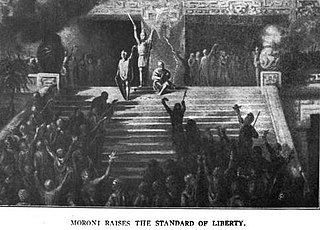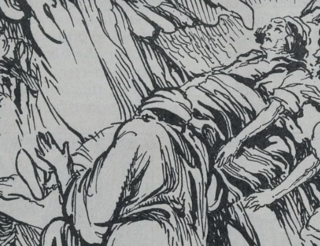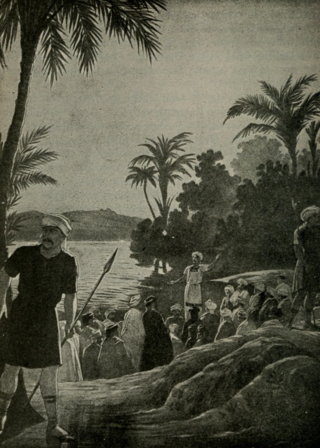
The Book of Alma: The Son of Alma, usually referred to as the Book of Alma, is one of the books that make up the Book of Mormon. The title refers to Alma the Younger, a prophet and "chief judge" of the Nephites. Alma is the longest book in the Book of Mormon and consists of sixty-three chapters, taking up almost a third of the volume.
The Book of Enos is the fourth book in the Book of Mormon and is a portion of the small plates of Nephi. According to the text it was written by Enos, a Nephite prophet. According to the Book of Mormon, Enos was the son of Jacob and nephew of Nephi.

The Book of Helaman is one of the books that make up the Book of Mormon, a text held sacred by churches within the Latter Day Saint movement, including the Church of Jesus Christ of Latter-day Saints. The book continues the history of the Nephites and the Lamanites from approximately 50 BC to 1 BC. It discusses political unrest among the Nephites and the formation of a group of secret dissenters called the Gadianton Robbers. Helaman, son of Helaman leads the Nephites for a time, and his sons Nephi and Lehi go on a successful mission to the Lamanites. When Nephi returns home, he correctly identifies the murderer of the chief judge using his prophetic powers, and sends a famine to the Nephite which lasts three years. After a digression from Mormon, the book of Helaman ends with Samuel the Lamanite's prophecy of the signs that will precede Christ's birth and death. Helaman deals with themes of external and internal conflict, hidden information, Nephite racism, and Mormon's views of history as deduced by his redaction of it.
The Book of Omni is one of the books that make up the Book of Mormon, a text that the Latter Day Saint movement regards as scripture. The book is written as the combined composition of several authors, the first of whom, Omni, provides the name of the book. According to the narrative, the book covers more than two centuries of Nephite history within one chapter of text. It refers to wars between the Nephites and Lamanites, the reign of Kings Mosiah and Benjamin, and their participation in the wars and journeys through the wilderness.
The Words of Mormon is one of the books that make up the Book of Mormon, a text that is held sacred in the Latter Day Saint movement. It consists of a single chapter of eighteen verses and is the only book in the text which is not titled as a 'book.' According to the text, it is a comment inserted by the prophet Mormon while compiling the records which became the Book of Mormon.

The Lamanites are one of the four peoples described as having settled in the ancient Americas in the Book of Mormon, a sacred text of the Latter Day Saint movement. The Lamanites also play a role in the prophecies and revelations of the Doctrine and Covenants, another sacred text in the Latter Day Saint movement.

Nephi is one of the central figures described in the Book of Mormon. In the Church of Jesus Christ of Latter-day Saints, he is described as the son of Lehi, a prophet, and the founder of the Nephite people. He is also the author of the first two books of the Book of Mormon, First and Second Nephi.

King Noah is a Nephite king in the Book of Mormon who appears in the Book of Mosiah. Noah rules over a Nephite colony who came from Zarahemla and settled in the land of Lehi-Nephi, succeeding his father, Zeniff. In the Book of Mosiah, King Noah breaks away from his father's righteous teachings, committing "all manner of wickedness." Noah and his priests sentence the prophet Abinadi, who prophesied of his kingdom's downfall if they did not repent, to death by fire. During a Lamanite invasion, Noah and some of his people flee the land, and those who remain are subjected to Lamanite control. Noah attempts to forbid his men from returning to their families, and they burn him at the stake. Noah is succeeded by his son, Limhi.

In the Book of Mormon, Alma, the son of Alma is a Nephite prophet often referred to as Alma the Younger to distinguish him from his father, who is often referred to as Alma the Elder. These appellations, "the Younger" and "the Elder," are not used in the Book of Mormon; they are distinctions made by scholars, useful because both individuals were prominent during the same time period in the Book of Mormon's story and filled a similar cultural and religious role. Alma is the namesake of the Book of Alma.

Zeniff is a king in the Book of Mormon whose personal account is recorded in the Book of Mosiah. He is the father of King Noah and the grandfather of King Limhi. Zeniff is the first king of Nephite colonists who come from Zarahemla and settle in the land of Lehi-Nephi. The Nephites believe this land to be rightfully theirs by inheritance, even attempting to reclaim the land by force. In an expedition in which he spies for the Nephites, Zeniff claims to see good in the Lamanite inhabitants. He argues against a militaristic approach and causes an internal battle among the Nephite army. Zeniff later leads a group of Nephites back to Lehi-Nephi and establishes a peace treaty with the Lamanite king whose people inhabit the land. Zeniff’s people prosper with him as king, but the Lamanite king betrays their treaty and attempts to exploit them. Zeniff and his people successfully fight off the Lamanites’ multiple aggressions, and Zeniff's reign lasts about forty years, after which he passes the kingship to one of his sons, Noah. Scholarly interpretations have highlighted Zeniff's shifting perceptions of Lamanites, such as how his opinion changes when his people contends with the Lamanites and the role that Zeniff's narration plays in racializing Lamanites in the Book of Mormon.

In the Book of Mormon, the waters of Mormon is a body of water where about two hundred Nephites are baptized.

Ammonihah is a city mentioned in the Book of Mormon described as governed by lawyers and judges. When the Book of Mormon prophet Alma visits Ammonihah as part of a preaching tour, the city becomes the setting of "one of the most disturbing episodes" of the text in which Ammonihah's governing elite imprison him, exile any men converted by his preaching, and kill women and children associated with his mission by fire.

Nehor is the founder of an apostate sect mentioned in the Book of Mormon around 90 BC in the first year of the reign of the judges. He teaches the Nephites that priests and teachers should be supported by their followers, and that all will be saved in the end. Nehor is brought before Alma the Younger for killing Gideon, a Nephite elder who argued with him. Alma accuses him of priestcraft and sentences him to death for enforcing his beliefs with violence. When executed, Nehor admits to teaching against the word of God.

In the Book of Mormon, Zeezrom is a Nephite lawyer who, through deceit and money, seeks to gain power among the Nephites through his vocation. Alma the Younger and his missionary companion Amulek teach Zeezrom in Ammonihah. At first he resists, but is ultimately converted to the Nephite religion.

The Amalekites, in the Book of Mormon, are a group of dissenters from the Nephites around 90 B.C. They are after the order of Nehor and therefore believe that there will not be a Messiah and repentance is unnecessary, so when Nephite missionaries come preach to them, only one Amalekite coverts. They also press the Lamanites to war against the Nephites multiple times and participate in the destruction of Ammonihah.

According to the Book of Mormon, the Amlicites were a break-off group of Nephites in the Book of Alma, around 87 B.C. Their leader, Amlici, is not chosen by the people as king, so he and the Amlicites leave the Nephites and join the Lamanites. The Nephites win both of their battles with the Amlicites and Alma kills Amlici in the second battle.

Amulek is a man referred to in the Book of Alma, a section of the Book of Mormon. After being visited by an angel, he gives food to the prophet Alma, listens to his preaching, and becomes his missionary companion. Alma and Amulek preach in Ammonihah and are challenged by lawyers, primarily Zeezrom, who accuses Amulek of lying and teaching against their laws. They are brought before the chief judge of the land. The men who believe their teachings are thrown out of the city and the women and children are burned in a fire, which Alma and Amulek are made to watch. Then, they are imprisoned until Alma's prayer gives them the strength to break free and the walls of the prison split in two.

Aminadab is a person in the Book of Mormon who appears in the Book of Helaman. He had been a member of the Nephite church but left it and became associated with the Lamanites. In the Book of Helaman, after Nephi abdicates the Chief Judgment Seat to Cezoram, he and his brother Lehi go to preach to the Lamanites, who imprison them. After a heavenly incident, Aminadab clarifies to the surrounding Lamanite captors that Nephi and Lehi are conversing with angels.

The following outline is provided as an overview of and topical guide to the Book of Mormon:

According to the Book of Mormon, Coriantumr (/ˌkɒriˈæntəmər/) was a Nephite dissenter and Lamanite captain. Coriantumr led the Lamanite armies against the Nephites in an attempt to conquer the land. He was countered by Moronihah and Lehi, eventually dying in battle.









